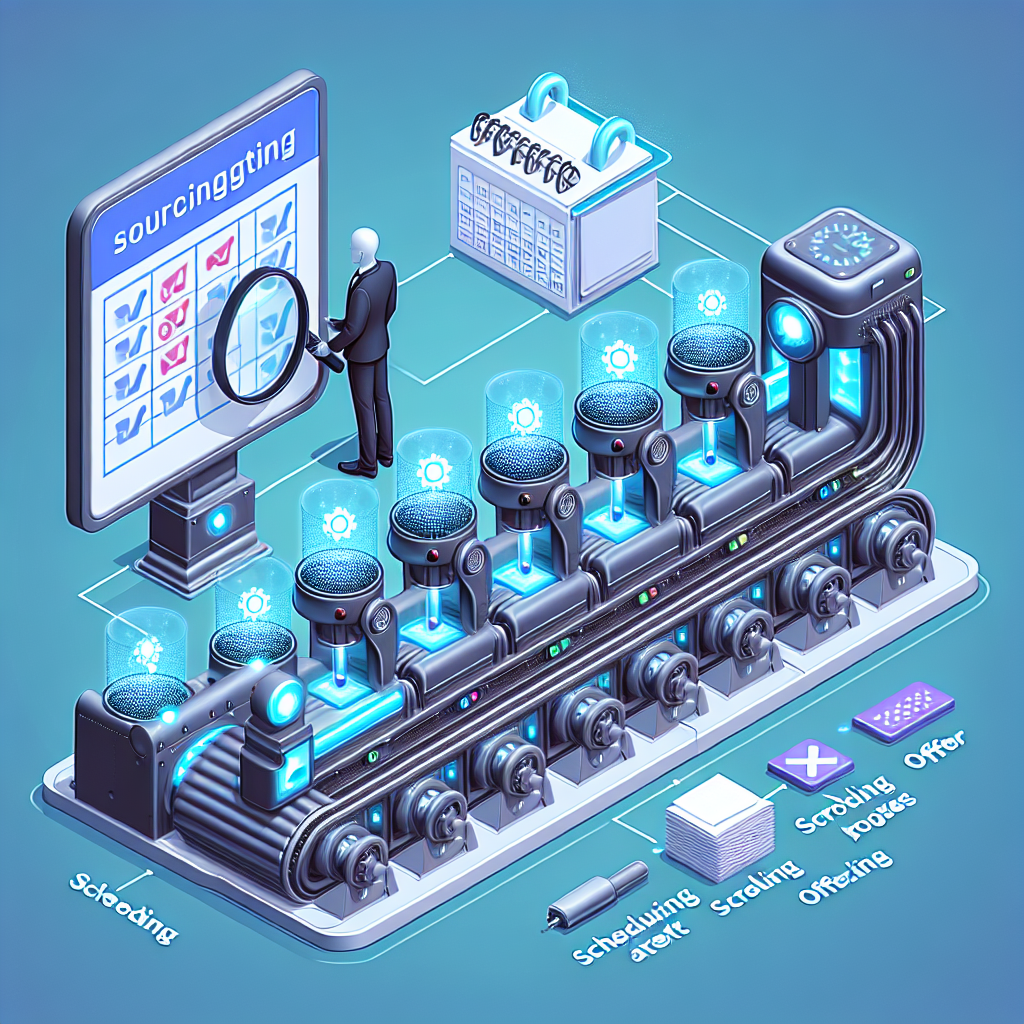Are you losing top candidates in the black hole of your current Applicant Tracking System (ATS)? Does your team spend more time on manual data entry and repetitive sourcing than on building relationships with quality talent? If you’re nodding along, you’re not alone. Many growing companies are shackled by outdated, inefficient recruitment workflows that actively sabotage their hiring goals. The war for talent is fierce, and your legacy software is a liability.
But what if you could transform your recruiting function from a frustrating cost center into a strategic, intelligent powerhouse?
This is not another article simply listing the benefits of AI. This is your definitive playbook for making that transformation a reality. We will guide you from diagnosing the deep-seated problems in your current process to confidently selecting the right AI-powered solution for your future. We’ll demystify the jargon, compare the old guard with the new, and provide a practical framework to audit your workflow and choose a system that delivers a true competitive advantage.
Here’s what you’ll find inside:
- A Recruitment Workflow Audit: A health check to diagnose and quantify the hidden costs of your legacy ATS.
- The AI Revolution Explained: A clear breakdown of basic automation vs. game-changing Agentic AI.
- The Definitive Buyer’s Guide: A head-to-head comparison of incumbent platforms and the new Agentic AI paradigm.
- The Future-Proof Playbook: Actionable steps to streamline your entire hiring process for maximum impact.
Let’s begin the journey from frustration to future-proof.
- Your Legacy ATS is Costing You: A Recruitment Workflow Audit
- The AI Revolution in Recruiting: From Basic Automation to Agentic AI
- The Definitive Buyer’s Guide: Comparing AI Agentic ATS vs. The Incumbents
- The Future-Proof Playbook: How to Streamline Your Hiring Process Today
- From Frustration to a Strategic Advantage
- Sources & References
Your Legacy ATS is Costing You: A Recruitment Workflow Audit

Before you can embrace the future, you must understand the true cost of the present. Your outdated ATS isn’t just clunky; it’s a drain on resources, a barrier to top talent, and a significant business risk. According to HR experts, an inefficient hiring process can be a “silent killer of business growth”[4], costing you not just in lost time but in missed opportunities and diminished competitiveness.
Let’s conduct a quick health check. If you recognize several of the following symptoms, it’s a clear sign your system is failing you.
The Telltale Signs: Is Your Recruitment Process Broken?
Use this checklist to score your current process. How many of these pain points feel familiar?
- Slow Time-to-Hire: Are your open roles sitting vacant for weeks or months, while competitors snap up the best candidates?
- High Candidate Drop-Off: Do promising applicants abandon your lengthy or confusing application process? A poor candidate experience is a hallmark of legacy systems[5].
- Recruiter Burnout: Is your team bogged down by repetitive, low-value tasks like manual candidate sourcing, data entry, and scheduling interviews?
- Lack of Visibility: Can you easily see where every candidate is in your pipeline, or is your data fragmented across spreadsheets and email inboxes?
- Poor Integration: Does your ATS refuse to play nicely with modern tools for communication, assessment, and HR management?
- Limited Mobile Functionality: In an era where talent is always on the move, a lack of mobile optimization is a critical failure[5].
To truly grasp the impact, it’s crucial to track key performance indicators (KPIs). Start measuring your Time-to-Fill (the days from job posting to offer acceptance), Cost-per-Hire, and Candidate Drop-off Rate at each stage. These metrics will move from anecdotal frustrations to hard data you can use to build a business case for change.
Why Manual Sourcing Fails in the Modern Talent Market
One of the biggest time sinks for any recruiting team is manual candidate sourcing. This traditional approach, which relies on keyword searches across job boards and LinkedIn, is fundamentally broken in today’s talent landscape. It’s not scalable, it’s inefficient, and it consistently misses the best candidates.
The core problem is that manual methods are reactive and limited. They fail to build sustainable talent pipelines—proactive, curated communities of potential candidates you can engage with over time. As experts at Lever.co have noted, building these pipelines manually is incredibly difficult and time-consuming[7]. Furthermore, this process often creates a poor candidate experience, where applicants feel like just another resume in a database rather than a valued professional.
The difference between this outdated method and a modern, AI-powered approach is stark.
| Feature | Manual Sourcing (The Old Way) | AI-Powered Sourcing (The New Way) |
|---|---|---|
| Method | Keyword-based searches on job boards. | Semantic search that understands context, skills, and potential. |
| Scope | Limited to active job seekers. | Uncovers both active and passive candidates across the entire web. |
| Efficiency | Hours of manual searching per role. | Autonomous discovery and ranking of top talent in minutes. |
| Data | Relies solely on resume text. | Analyzes a rich data set: code repositories, publications, social activity. |
| Scalability | Extremely low; linear effort per role. | Highly scalable; can build talent pipelines for multiple roles simultaneously. |
As this comparison based on insights from sources like Index.dev shows[6], clinging to manual sourcing is like trying to win a Formula 1 race with a horse and buggy. You’re simply not equipped for the modern competitive landscape.
The AI Revolution in Recruiting: From Basic Automation to Agentic AI
The solution to these deep-seated problems lies in leveraging artificial intelligence. However, not all “AI” is created equal. The market is flooded with platforms claiming to be AI-powered, but their capabilities vary dramatically. To make an informed decision, you need to understand the different levels of automation maturity.
To clarify, let’s define some key terms:
- Linear Automation: This is the most basic form. It follows simple, pre-programmed “if-then” rules. For example, if a candidate applies, then send a confirmation email. Most traditional ATS platforms operate at this level.
- AI-Powered Automation: This is a step up. It uses machine learning to perform more complex tasks, like matching keywords on a resume to a job description to generate a “fit score.”
- Agentic AI: This is the game-changer. An AI Agent is an autonomous system that can understand a goal, create a plan, and execute complex, multi-step tasks across different tools to achieve it. It can learn from feedback and adapt its strategy. As experts at KABi.ai explain, it’s the difference between a tool that follows a script and a digital teammate that can think and coordinate[1].
Successfully implementing this advanced technology requires a strategic approach. It’s not just about buying software; it’s about rethinking your entire workflow. As industry analysts at Carv.com point out, the path to leveraging agentic AI involves understanding both its immense potential and the practical realities of integration and change management[2]. The rapid evolution of these technologies is a key reason why organizations must stay informed, with resources like the World Economic Forum’s Future of Jobs Report highlighting the profound impact of AI on the workforce[14].
What’s the Difference? Agentic AI vs. Traditional ATS Automation
To make this concrete, let’s consider a real-world hiring scenario: finding and engaging a Senior Software Engineer.
A Traditional ATS with Linear Automation might:
- Allow a recruiter to post the job to multiple boards.
- Automatically send a confirmation email to applicants.
- Allow the recruiter to manually filter candidates by keywords like “Java” or “Python.”
- Require the recruiter to manually schedule interviews for each shortlisted candidate.
Each step is a separate, manual action initiated by the recruiter. The system is a passive database.
An AI Agentic ATS would:
- Understand the Goal: “Hire a top-tier Senior Software Engineer with expertise in distributed systems.”
- Create a Plan: The AI Agent determines it needs to source from GitHub, LinkedIn, and internal databases; screen for technical skills and cultural fit; and engage the top 5 candidates.
- Execute Autonomously:
- It scours the web to identify 50 potential candidates, analyzing their code contributions and project history, not just their resumes.
- It screens and ranks these candidates based on a deep understanding of the role’s requirements, shortlisting the top 10.
- It drafts personalized outreach emails for the top 5, referencing their specific projects.
- It cross-references the hiring manager’s calendar and the candidates’ stated availability to propose interview times, handling all the back-and-forth scheduling.
- Learn and Adapt: If the hiring manager rejects the first batch of candidates, the agent analyzes the feedback and refines its search criteria for the next round.

This is the core difference: an AI Agentic ATS is an active, intelligent partner in the recruitment process. It doesn’t just automate tasks; it orchestrates the entire workflow.
| Capability | Traditional ATS Automation | AI Agentic ATS |
|---|---|---|
| Adaptability | Low (Follows rigid, pre-set rules) | High (Learns from feedback and adapts strategy) |
| Learning Capability | None | Continuous improvement based on hiring outcomes |
| Coordination | Low (Siloed, single-task functions) | High (Orchestrates complex, multi-step workflows) |
| Autonomy | Low (Requires constant human input) | High (Can execute entire strategies with minimal oversight) |
As we embrace more complex AI systems, it’s also vital to manage their risks responsibly, using frameworks like the NIST AI Risk Management Framework to guide development and deployment[13].
The Definitive Buyer’s Guide: Comparing AI Agentic ATS vs. The Incumbents

Now that you understand the technological leap, it’s time to navigate the market. The global market for AI-powered HR software was valued at $7.01 billion in 2024 and is projected to grow significantly[3], meaning more options—and more confusion—for buyers. This guide will provide the clarity you need to make a strategic choice. For broader context on how AI is being adopted across the industry, SHRM’s State of AI in HR Report offers valuable insights[12].
Your AI Recruiting Platform Buyer’s Checklist
Before you even look at a demo, arm yourself with these critical questions to cut through the marketing hype and avoid “AI-washing”:
- Go Beyond the “What”: Don’t just ask, “Do you use AI?” Ask, “Can you show me how your AI autonomously sources, screens, and engages candidates for a role without manual intervention?”
- Probe the Learning Mechanism: Ask, “How does your system learn from my team’s feedback? If we reject a candidate, how does the AI use that information to improve future searches?”
- Test for True Coordination: Ask, “Can your system manage the entire workflow from sourcing to scheduling interviews for five candidates simultaneously, or does it just automate individual tasks?”
- Demand Data Transparency: Ask, “What data sources does your AI use to evaluate candidates beyond their resume? How do you ensure that data is relevant and up-to-date?”
Red Flag: If a vendor’s answer to “how” their AI works is vague or constantly defaults to “it creates a match score,” they are likely offering basic AI-powered automation, not a true Agentic system.
Evaluating the Established Players: Ceipal, Jobdiva, and Oorwin
Platforms like Ceipal, Jobdiva, and Oorwin are well-known in the recruiting world, particularly within staffing agencies. They have built robust platforms with deep feature sets for managing the traditional recruitment lifecycle.
- Strengths: These incumbents typically excel at core ATS and CRM functionalities. They offer extensive tools for job posting, client management, and tracking applicants through a linear pipeline. User reviews often praise their comprehensive nature for managing high volumes of activity.
- The “AI” Question: While these platforms have incorporated AI features, it’s crucial to analyze how. Their AI often focuses on enhancing existing processes rather than creating new, autonomous ones. This typically includes AI-powered resume parsing to extract data, keyword-based matching to rank applicants against a job description, and some automated email triggers.
- The Gap: The fundamental limitation is that these systems still require a human to be the primary driver of the workflow. The AI assists the recruiter; it does not act as an autonomous agent on their behalf. They streamline the old way of working but don’t fundamentally transform it.
Who are they for? Organizations that are deeply invested in a traditional, recruiter-driven workflow and are looking for a powerful tool to manage and track that process with some AI-assisted efficiencies.
The Agentic AI Advantage: A New Paradigm for Talent Acquisition
Agentic AI platforms represent a fundamental shift from a system of record to a system of action. They are built on the premise that the most valuable use of a recruiter’s time is not searching and coordinating but engaging with top-tier, pre-vetted candidates.
The strategic business case is compelling. By automating the entire top-of-funnel, these platforms free up recruiters to focus on building relationships, selling the company vision, and closing candidates. As leaders from firms like KABi.ai and Carv.com suggest, the future of recruitment AI is one where technology handles the ‘find and filter’ work, allowing humans to excel at the ‘connect and convince’ work[1], [2].
Consider a mini-case study based on real-world results: A mid-sized tech company was struggling with a 60-day time-to-hire for critical engineering roles. By implementing an AI platform that automated sourcing, screening, and initial outreach, they empowered their recruiters to focus only on the top 5% of candidates. The result? They reduced their time-to-hire by over 30% in the first quarter, mirroring efficiency gains seen by companies adopting advanced automation[8].
Who are they for? Forward-thinking organizations that want to build a scalable, future-proof talent acquisition function. They are ideal for companies in competitive markets who need to find and engage passive talent before their competitors do.
Key Considerations: Integration, Data Security, and Ethical AI
Choosing a new platform isn’t just about features; it’s about trust and responsibility.
- Integration: Any new system must integrate seamlessly with your existing HR tech stack (HRIS, payroll, etc.). Ask potential vendors for a list of their native integrations and their API capabilities for custom connections.
- Data Security: Your ATS holds sensitive candidate data. Ensure any platform you consider is compliant with data privacy regulations like GDPR and CCPA. Look for certifications like SOC 2 compliance.
- Ethical AI: AI has the potential to reduce human bias, but it can also perpetuate it if not designed carefully. Ask vendors how their algorithms are tested for fairness and what steps they take to mitigate bias. A commitment to ethical AI is non-negotiable. Modern systems are increasingly built with compliance in mind, a critical consideration detailed in resources like the EEOC Guidance on AI in Hiring[11].
The Future-Proof Playbook: How to Streamline Your Hiring Process Today
Adopting a new tool is only part of the solution. To truly transform your talent acquisition, you must optimize the process that the tool supports. Use this 10-point plan, which incorporates expert advice from HR consultancies[9], [10], to build a modern, efficient, and candidate-centric hiring engine.

- Define the Role Before You Search: Work with hiring managers to create a detailed “success profile,” not just a job description. Define the core competencies, key outcomes, and must-have skills.
- Write Compelling, Inclusive Job Descriptions: Ditch the corporate jargon. Write job posts that sell the opportunity, reflect your company culture, and use inclusive language to attract a diverse pool of candidates.
- Automate the Top of the Funnel: Use your new AI platform to handle sourcing, screening, and initial outreach. Set the goals and let the system find and engage the best talent.
- Structure Your Interviews: Create a standardized interview plan for each role with specific questions tied to the success profile. This ensures every candidate is evaluated fairly and consistently.
- Train Your Interviewers: Don’t assume everyone is a great interviewer. Provide training on effective questioning techniques, bias awareness, and how to sell the company vision.
- Prioritize the Candidate Experience: Keep candidates informed at every stage. Provide clear timelines, offer constructive feedback when possible, and ensure every interaction is professional and respectful. Remember to balance automation with the “human touch.”
- Streamline Scheduling: Use automated scheduling tools to eliminate the endless email chains of finding a time that works for everyone.
- Create a Collaborative Feedback Loop: Implement a system where interviewers can submit their feedback immediately after an interview. Use a standardized scorecard to make decisions data-driven, not just gut-driven.
- Move Quickly on Offers: When you find the right candidate, don’t wait. A slow offer process is one of the easiest ways to lose top talent to a competitor.
- Measure, Analyze, and Iterate: Continuously track your recruitment KPIs. Use the data to identify new bottlenecks and refine your process over time.
By combining a powerful Agentic AI platform with a streamlined, strategic process, you create an unstoppable talent acquisition machine.
From Frustration to a Strategic Advantage
The days of tolerating a clunky, inefficient ATS are over. Clinging to outdated software and manual workflows isn’t just frustrating—it’s a strategic failure that costs you top talent, burns out your team, and holds your business back.
You’ve now seen the clear path forward. It begins with an honest audit of your current process, recognizing the signs of a broken system. It progresses with a clear understanding of the technological leap from basic automation to the autonomous power of Agentic AI. And it culminates in making a confident, informed decision using a strategic buyer’s framework. By choosing a tool that acts as an intelligent partner, you can free your team to do what they do best: build the human connections that build great companies.
The future of recruiting is not about replacing recruiters; it’s about empowering them. It’s time to stop managing a database and start building a strategic talent powerhouse.
Ready to transform your recruitment from a cost center to a strategic powerhouse? Download our free ‘AI ATS Evaluation Scorecard’ to start your journey today, or schedule a demo to see how [Our Product Name] puts Agentic AI to work for you.
This article reviews and compares various software platforms. It may contain affiliate links, meaning we may earn a commission if you make a purchase through our links, at no extra cost to you. All opinions are based on our independent research.
Sources & References
- KABi.ai. (n.d.). Agentic AI vs. Automation: Smarter Hiring, Decoded. Retrieved from kabi.ai/blog/agentic-ai-vs-automation-smarter-hiring-decoded/
- Carv.com. (n.d.). Building Agentic AI in the ATS: Roadblocks, Realities, and Strategic Paths. Retrieved from www.carv.com/guides/building-agentic-ai-in-the-ats-roadblocks-realities-and-strategic-paths
- HireEZ.com. (n.d.). Best AI Recruiting Software. Retrieved from explore.hireez.com/blog/best-ai-recruiting-software
- CypressHCM.com. (n.d.). Inefficient Hiring Processes: The Silent Killer of Business Growth. Retrieved from www.cypresshcm.com/inefficient-hiring-processes-the-silent-killer-of-business-growth/
- Screenloop.com & Jobylon.com. (N.D.). Insights derived from analysis of Why Legacy Applicant Tracking Systems Fail and Legacy ATS: Overcoming Limitations and Transitioning Towards Modern Recruitment Tools.
- Index.dev. (N.D.). Insights derived from analysis of AI Candidate Sourcing Guide.
- Lever.co. (N.D.). Insights derived from analysis of Candidate Sourcing Strategies.
- BambooHR. (N.D.). [Data on efficiency gains from applicant tracking functionality]. Statistic concept derived from research.
- CPS HR Consulting. (N.D.). Insights derived from analysis of Streamline Your Recruitment Process.
- Action Group. (N.D.). Insights derived from analysis of Streamline Your Hiring Process & Reduce Time-to-Fill.
- U.S. Equal Employment Opportunity Commission. (n.d.). Select Issues: Assessing Adverse Impact in Software, Algorithms, and Artificial Intelligence Used in Employment Decisions Under Title VII of the Civil Rights Act of 1964. Retrieved from https://www.eeoc.gov/select-issues-assessing-adverse-impact-software-algorithms-and-artificial-intelligence-used
- Society for Human Resource Management. (n.d.). The State of AI in HR Report. Retrieved from https://www.shrm.org/topics-tools/research/state-of-ai-in-hr-report
- National Institute of Standards and Technology. (n.d.). AI Risk Management Framework. Retrieved from https://www.nist.gov/artificial-intelligence/ai-risk-management-framework
- World Economic Forum. (2023). The Future of Jobs Report 2023. Retrieved from https://www.weforum.org/publications/the-future-of-jobs-report-2023/